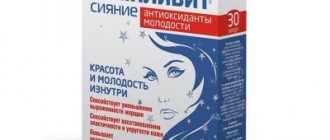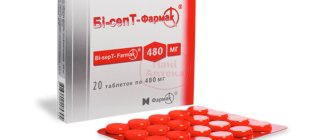Write a review
Reviews: 0
Manufacturers: Remedica (Cyprus)
Active ingredients
- Triamcinolone
Disease class
- Idiopathic thrombocytopenic purpura
- Asthma
- Crohn's disease [regional enteritis]
- Ulcerative colitis
- Atopic dermatitis
- Dermatitis, unspecified
- Seropositive rheumatoid arthritis
- Systemic lupus erythematosus
- Ankylosing spondylitis
- Nephrotic syndrome
- Other specified general symptoms and signs
- Disorders of plasma protein metabolism, not elsewhere classified
Clinical and pharmacological group
- Not indicated. See instructions
Pharmacological action
- Anti-inflammatory
- Antiallergic
- Immunosuppressive
Pharmacological group
- Glucocorticoids
Indications for use of the drug Triamcinolone
Systemic use - rheumatoid arthritis, rheumatism, systemic lupus erythematosus and other collagenoses, acute allergic and severe skin-allergic reactions, severe forms of asthma, hemorrhagic diathesis, lymphoproliferative processes; intra-articular injection - an inflammatory process in one of several joints during chronic diseases, exudative arthritis, gout, an active form of arthrosis; injection into the affected area - periostitis, bursitis, exostosis, tendovaginitis, lateral brachial epicondylitis ("tennis elbow"), limited nodular skin lesions, isolated psoriatic plaques, etc. Externally - vasculitis, pemphigus, neurodermatitis, eczema, exfoliative dermatitis, diaper rash, psoriasis , prurigo, insect bites.
pharmachologic effect
GCS inhibits the release of interleukin1, interleukin2, interferon gamma from lymphocytes and macrophages. Induces the formation of lipocortin, inhibits the release of inflammatory mediators by eosinophils and stabilizes mast cell membranes. Has anti-inflammatory, anti-allergic, anti-edema effects. Reduces bronchial hyperreactivity, restores receptor sensitivity to beta-adrenergic stimulants; stabilizes mast cell membranes, reduces the number of mast cells, macrophages, T-lymphocytes and eosinophils in the epithelium and submucosal layer of the bronchi. In therapeutic doses, it has virtually no systemic effect and does not suppress the function of the adrenal cortex; does not cause Na+ retention in the body and the appearance of edema. Increases glycogenesis, activates catabolic processes.
Use of the drug Triamcinolone
Orally at a dose of 4–16 mg/day in 2–4 doses. When a therapeutic effect is achieved, the dose is gradually (by 2 mg/day) reduced to a maintenance dose - usually to 1 mg/day. For systemic treatment, adults and adolescents over 16 years of age in the form of a suspension of 40 mg are administered deeply intramuscularly; in severe forms of disease, the dose can be doubled. Deep injection avoids possible tissue atrophy at the injection site. After the injection, you should press a sterile napkin tightly to the injection site for 1–2 minutes to prevent the suspension from leaking out of the injection channel. If it is necessary to perform several injections, an interval of at least 4 weeks should be maintained between them. When used intra-articularly, the dose is determined by the size of the joint and the severity of symptoms; adults and children over 12 years of age are usually prescribed in the following doses: small joints (phalanxes of the fingers of the upper and lower extremities) - 10 mg; medium-sized joints (shoulder, elbow) - 30 mg; large joints (hip, knee) - 40 mg. If multiple joints are affected, the total amount of triamcinolone administered may be 80 mg. For intralesional use for bursitis, periostitis and exostosis, adults and children over 12 years of age, depending on the size and location of the lesions, are administered: for minor lesions - up to 10 mg; for moderate and extensive - from 10 to 40 mg. Locally in the form of 0.1% ointment or cream 2-3 times a day for several days. Occlusive dressings enhance the therapeutic effect. Repeated courses of treatment can be carried out at intervals of several days.
Instructions:
Clinical and pharmacological group
04.001 (GCS for oral use)
pharmachologic effect
GKS. Suppresses the functions of leukocytes and tissue macrophages. Limits the migration of leukocytes to the area of inflammation. It disrupts the ability of macrophages to phagocytose, as well as to form interleukin-1. Helps stabilize lysosomal membranes, thereby reducing the concentration of proteolytic enzymes in the area of inflammation. Reduces capillary permeability due to the release of histamine. Suppresses fibroblast activity and collagen formation.
Inhibits the activity of phospholipase A2, which leads to suppression of the synthesis of prostaglandins and leukotrienes. Suppresses the release of COX (mainly COX-2), which also helps to reduce the production of prostaglandins.
Reduces the number of circulating lymphocytes (T- and B-cells), monocytes, eosinophils and basophils due to their movement from the vascular bed into the lymphoid tissue; suppresses the formation of antibodies.
Triamcinolone suppresses the pituitary release of ACTH and β-lipotropin, but does not reduce the level of circulating β-endorphin. Inhibits the secretion of TSH and FSH.
When directly applied to blood vessels, it has a vasoconstrictor effect.
Triamcinolone has a pronounced dose-dependent effect on the metabolism of carbohydrates, proteins and fats. Stimulates gluconeogenesis, promotes the uptake of amino acids by the liver and kidneys and increases the activity of gluconeogenesis enzymes. In the liver, triamcinolone enhances the deposition of glycogen, stimulating the activity of glycogen synthetase and the synthesis of glucose from protein metabolism products. An increase in blood glucose levels activates the release of insulin.
Triamcinolone inhibits the uptake of glucose into fat cells, which leads to activation of lipolysis. However, due to increased insulin secretion, lipogenesis is stimulated, which promotes fat accumulation.
It has a catabolic effect in lymphoid and connective tissue, muscles, adipose tissue, skin, bone tissue.
Osteoporosis and Itsenko-Cushing syndrome are the main factors limiting long-term GCS therapy. As a result of the catabolic effect, growth suppression in children is possible.
In high doses, triamcinolone can increase the excitability of brain tissue and help lower the seizure threshold. Stimulates excess production of hydrochloric acid and pepsin in the stomach, which contributes to the development of peptic ulcers.
When used systemically, the therapeutic activity of triamcinolone is due to its anti-inflammatory, antiallergic, immunosuppressive and antiproliferative effects.
When applied externally and locally, the therapeutic activity of triamcinolone is due to its anti-inflammatory, antiallergic and antiexudative (due to the vasoconstrictor effect) effect.
When used inhalation, it has an anti-inflammatory effect on the bronchial mucosa in patients with bronchial asthma. With constant use, it reduces the number of mast cells, macrophages, T-lymphocytes and eosinophils in the epithelium and submucosal layer of the bronchi, and suppresses airway hyperreactivity.
In terms of anti-inflammatory activity, triamcinolone is close to hydrocortisone, and triamcinolone acetonide is 6 times more active. Triamcinolone and triamcinolone acetonide have virtually no mineralocorticoid activity.
Pharmacokinetics
Metabolized mainly in the liver and partially in the kidneys. The main route of metabolism is 6-beta-hydroxylation. T1/2 - 3.5 hours. Excreted by the kidneys.
Dosage
Orally for adults - 4-20 mg per day in 2-3 divided doses. After improvement of the condition, the daily dose is gradually reduced by 1-2 mg every 2-3 days to a minimum maintenance dose of 1 mg and complete discontinuation of therapy.
IM at the beginning of treatment - 40 mg once every 4 weeks. Then, depending on the indication and the patient's response to treatment, 40-80 mg can be administered every 2-4 weeks. If necessary, a single dose can be increased to 100 mg. To avoid subcutaneous atrophy, it is injected deep into the muscle.
When administered intra-articularly, as well as when administered into the affected area, the dose is 10-40 mg. The interval between administrations is at least 1 week.
For inhalation use, the dose depends on the dosage form used and the age of the patient.
Apply externally 1-3 times/day. The duration of treatment is determined individually and is usually 5-10 days. If the disease persists, the course of treatment can be extended to 25 days. Use for more than 4 weeks is not recommended.
Drug interactions
When used simultaneously with anabolic steroids and androgens, the risk of developing peripheral edema and acne increases.
When used simultaneously with antithyroid drugs and thyroid hormones, changes in thyroid function may occur.
When used simultaneously with histamine H1 receptor blockers, the effect of triamcinolone is reduced; with hormonal contraceptives - the effect of triamcinolone is potentiated.
Hypocalcemia associated with the use of triamcinolone may lead to an increase in the duration of neuromuscular blockade caused by the action of depolarizing muscle relaxants when used concomitantly.
When used simultaneously with immunosuppressants, the risk of developing bacterial and viral infections increases.
When used simultaneously with potassium-sparing diuretics, hypokalemia is possible.
With simultaneous use, it is possible to reduce the effectiveness of indirect anticoagulants, heparin, streptokinase, urokinase, and increase the risk of erosive and ulcerative lesions and bleeding from the gastrointestinal tract.
When used simultaneously with NSAIDs (including acetylsalicylic acid), the risk of erosive and ulcerative lesions and bleeding from the gastrointestinal tract increases.
With simultaneous use, the effect of oral hypoglycemic agents and insulin is weakened; with laxatives - hypokalemia is possible; with cardiac glycosides - the risk of developing heart rhythm disturbances and other toxic effects of glycosides increases.
When used simultaneously with tricyclic antidepressants, an increase in mental disorders associated with triamcinolone may be possible.
When used simultaneously with m-anticholinergic blockers (including atropine), intraocular pressure may increase.
When used simultaneously with amphotericin B and carbonic anhydrase inhibitors, there is a risk of developing hypokalemia, left ventricular myocardial hypertrophy and circulatory failure.
When used simultaneously with isoniazid, a decrease in the concentration of isoniazid in the blood plasma is possible, mainly in individuals with rapid acetylation.
With simultaneous use, it is possible to accelerate biotransformation and reduce the concentration of mexiletine in the blood plasma.
When used simultaneously with paracetamol, the risk of developing hypernatremia, peripheral edema, increased calcium excretion, hypocalcemia, osteoporosis, and hepatotoxicity of paracetamol increases.
When used simultaneously with rifampicin, phenytoin, carbamazepine, barbiturates, the metabolism of triamcinolone is accelerated due to the induction of microsomal liver enzymes, and its effect is reduced.
When used simultaneously with ephedrine, the metabolism of triamcinolone is accelerated.
Use during pregnancy and lactation
If use is necessary during pregnancy (especially in the first trimester) and lactation, the expected benefit to the mother and the risk of side effects in the fetus or child should be assessed.
Side effects
From the endocrine system: redistribution of adipose tissue, menstrual irregularities, increased blood glucose levels, suppression of adrenal function, “moon face”, stretch marks, hirsutism, acne.
Metabolism: edema, electrolyte imbalance, negative nitrogen balance, growth retardation in children.
From the digestive system: steroid gastric ulcer, erosive and ulcerative lesions of the gastrointestinal tract, acute pancreatitis.
From the central nervous system: convulsions, sleep disturbances, mental disorders, headaches and dizziness, weakness.
From the musculoskeletal system: myopathy, osteoporosis.
From the cardiovascular system: arterial hypertension.
From the blood coagulation system: thromboembolism.
From the organ of vision: visual disturbances, posterior subcapsular cataracts, increased intraocular pressure or exophthalmos, anaphylactic reactions.
Reactions caused by immunosuppressive effects: exacerbation of infectious diseases.
With intra-articular administration: possible joint pain, irritation at the injection site, depigmentation, sterile abscess, skin atrophy; when administered in doses of more than 40 mg, resorptive side effects are possible.
With inhalation use: possible headache, sneezing, cough, dryness of the oral or nasal mucosa, irritation in the nose, hoarseness, and rarely, a fungal infection of the nasopharynx caused by Candida albicans.
When used externally: possible itching, skin irritation, late reactions such as eczema, steroid acne, purpura. With prolonged use of the ointment, the development of secondary infectious lesions and atrophic changes in the skin is possible.
Indications
For oral administration: rheumatism, rheumatoid arthritis, systemic lupus erythematosus and other collagenoses, acute allergic reactions, allergic skin diseases, severe forms of bronchial asthma, erythema multiforme, hemorrhagic diathesis, hemolytic anemia, lymphoma, leukemia.
For parenteral use: rheumatoid arthritis, connective tissue diseases, systemic lupus erythematosus, dermatoses, emphysema and pulmonary fibrosis, lymphosarcoma, lymphogranulomatosis, lymphatic leukemia, nephrotic syndrome, sprue.
For inhalation use: bronchial asthma in the acute phase. Insufficient effectiveness of bronchodilators and/or mast cell membrane stabilizers in the treatment of bronchial asthma. Hormone-dependent bronchial asthma (in order to reduce the dose of GCS for oral administration). Allergic rhinitis.
For external use: eczema, psoriasis, neurodermatitis, various types of dermatitis and other inflammatory and allergic skin diseases of non-microbial etiology (as part of complex therapy).
Contraindications
History of acute psychosis, active form of tuberculosis, myasthenia gravis, neoplasms with metastases, diverticulitis, gastric and duodenal ulcers, arterial hypertension, Itsenko-Cushing syndrome, renal failure, history of thrombosis and embolism, osteoporosis, diabetes mellitus, hidden foci of infection, amyloidosis, syphilis, fungal diseases, viral infections (including those caused by Herpes simplex and Varicella zoster), amoebic infections, poliomyelitis (except for the bulbar-encephalitis form), gonococcal or tuberculous arthritis, vaccination period, lymphadenitis after BCG vaccination, glaucoma , infected skin lesions.
special instructions
Not intended for intravenous administration.
Use with caution and under strict medical supervision for edema syndrome, obesity, mental illness and gastrointestinal diseases. During treatment, it is recommended to take vitamin D and eat foods rich in calcium.
After a single intramuscular injection of 60-100 mg for 24-48 hours, suppression of adrenal function may be observed, which usually recovers after 30-40 days.
For external use, to prevent local infectious complications, it is recommended to use it in combination with antimicrobial agents.
Parenteral use in children under 6 years of age is not recommended; at the age of 6-12 years - according to strict indications.
Long-term external use should be avoided in children regardless of age.
Use for renal impairment
Contraindicated: renal failure.
special instructions
Only a doctor should prescribe a medicine, after carefully studying the results of a complete examination of the patient and making a final diagnosis.
The drug Triamcinolone is contraindicated for intravenous administration, as indicated in the official instructions for use.
The method of parenteral administration of the drug is not recommended for the treatment of patients under 6 years of age. In the period from 6 to 12 years, the presented technique is determined by a doctor if there are medical indications.
Properties
The principle of action of the active substance is the ability to suppress the properties of tissue macrophages, leukocytes, fibroblasts and collagen formation. Due to this, fewer cells arrive at the pathological site, which increase inflammation.
The instructions for use characterize triamcinolone as a more effective anti-inflammatory drug than hydrocortisone. This effect is 6 times stronger in the synthetic analogue. But at the same time, there is practically no mineralocorticoid activity with a negative effect on the water-mineral balance of the body.
Contraindications
This substance is contraindicated:
- patients with diverticulitis ;
- if the patient has a history of acute psychosis or other diseases of the nervous system;
- with myasthenia gravis ;
- patients with an active form of tuberculosis ;
- for and duodenal ulcers ;
- patients with metastatic malignant tumors ;
- with high blood pressure ;
- persons with kidney diseases;
- with Itsenko-Cushing syndrome ;
- if the patient has previously been diagnosed with thrombosis and embolism ;
- for osteoporosis , diabetes , amyloidosis ;
- patients with fungal and viral diseases, including herpes , polio , gonococcal or tuberculous arthritis ;
- in the period after vaccination ;
- for glaucoma , infectious skin diseases.
Interaction
Concomitant use of tricyclic antidepressants can lead to mental disorders.
The combined use of the drug and NSAIDs increases the irritating effect on the gastrointestinal mucosa and can lead to bleeding from the gastrointestinal tract and ulcerative and erosive lesions.
H1 receptor blockers reduce the effectiveness of Triamcinolone, and hormonal contraceptives, on the contrary, potentiate the effect of GCS .
When combining the drug with androgens and anabolics, the likelihood of developing acne and peripheral edema increases.
To avoid the development of bacterial and viral infections, the drug is not recommended to be combined with other immunosuppressants .
Use caution when combining the drug with thyroid hormones and antithyroid drugs ; such a combination can lead to disturbances in the functioning of the thyroid gland .
The simultaneous use of the drug and depolarizing muscle relaxants may lead to an increase in the duration of neuromuscular blockade due to hypocalcemia .
The substance may reduce the effectiveness of indirect anticoagulants , streptokinase , heparin , urokinase . Also, Triamcinolone, when combined with these drugs, increases the likelihood of developing bleeding in the gastrointestinal tract , erosion and gastric ulcers .
During treatment, insulin , laxatives, cardiac glycosides , and oral hypoglycemic drugs .
M-anticholinergic drugs , including atropine , can lead to increased intraocular pressure .
Caution should also be exercised during treatment with Triamcinolone and taking amphotericin B , carbonic anhydrase inhibitors , isoniazid , mexiletine , paracetamol , rifampicin , carbamazepine , phenytoin , ephedrine .
Potassium-sparing diuretics may lead to hypokalemia .
Pharmacodynamics and pharmacokinetics
The drug has the ability to activate specific receptors that are located in the cytoplasmic membrane target organ cells . The substance promotes the synthesis of messenger RNA and the formation of lipocortin proteins . One of these proteins, lipomodulin, inhibits the enzyme phospholipase A2 .
The product affects all types of metabolic processes and has anti-anabolic and catabolic effects . Triamcinolone also reduces the need for glucose in tissues that depend on insulin , stimulates the production of glycogen in the liver and lipid .
Under the influence of drugs based on this compound, sodium and water ions are retained and potassium ions parathyroid hormone , which is responsible for the mobilization of calcium from bone tissue, begins to be released more intensely Due to the ability of the substance to stabilize the membranes of mast cells and lysosomes , stop the proliferation of connective tissue, stop the liberation of arachidonic acid and reduce the level of its metabolism, Triamcinolone preparations have pronounced anti-inflammatory activity.
The immunosuppressive and antiallergic effect of the drug is due to the ability to reduce the number of B and T lymphocytes , disrupt their interaction, and reduce the content of immunoglobulin in the blood serum.
The substance also has an antitoxic and anti-shock effect on the body, increases blood pressure , increases the concentration of catecholamines , restores the functioning of adrenergic receptors , reduces vascular permeability, and activates liver enzymes.
After oral administration, the drug is absorbed by 25% through the walls of the gastrointestinal tract . The maximum effect is noticeable after 60-120 minutes. When administered intramuscularly, this indicator is observed after 1-2 days. About 68% of the active component binds to blood plasma proteins. For the tablet form, half-life = 5 hours. The effect of taking the tablets lasts for 2.5 days, after intramuscular injection - up to 6 weeks, when administered into the joint cavity - several weeks. is metabolized in the liver, the resulting metabolites are inactive. The drug is excreted through the kidneys and intestines.



